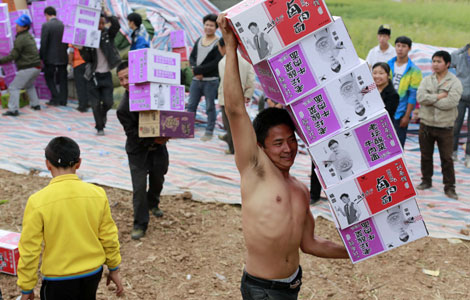Dawn of China's foreign trade recovery
Updated: 2012-11-12 15:36
(bjreview.com.cn)
|
||||||||
Also, the processing industry used to account for more than half of the total trade volume, but now the proportion has dropped to 42 percent.
Five years ago, China put forward a development strategy for restructuring the economy, aiming to shift its economy from one dependent on exports to one driven by consumption.
Yao Jian, spokesman of the MOFCOM, said the most prominent change to China's foreign trade in 2012 was that general trade grew more rapidly than the processing industry, which indicates that China is relying less on processing fees.
The MOFCOM figures show that in the first three quarters, China's general trade grew by 5.9 percent over a year ago. Of the total, exports rose by 8.3 percent and imports by 3.6 percent, which were respectively 5.3 percentage points and 2.6 percentage points higher than those of the processing industry.
Another point of interest is that while exports to traditional destinations decline, China's exports to emerging markets are growing rapidly. For example, exports to the Association of Southeast Asian Nations and Russia increased by 16.6 percent and 14.5 percent respectively.
Third, exports of independent brands account for a larger proportion. Among all exporting enterprises, 20 percent have independent brands.
Yao said in the future, China will face greater pressure to shift its economy because costs have risen rapidly in recent years, weakening the competitiveness of China's manufacturing industries to some extent.
From 2008 to 2011, the per capita annual salary for urban manufacturing employees grew at an average annual rate of 14.5 percent and that of migrant workers in manufacturing industries grew by 15 percent. As industrialization in neighboring countries accelerates, some enterprises are shifting operations elsewhere.
In the first seven months of this year, the market share of China's seven categories of traditional labor-intensive products exported to the United States, Europe and Japan declined by 2.1 percentage points, 1.4 percentage points and 2.7 percentage points respectively. Most of the lost shares were squeezed by China's neighboring low-cost countries.
"When external demand declines, China's labor-intensive products are facing growing international competition," said Yao. "Therefore export-oriented enterprises should shift to high-end manufacturing and focus on enhancing product quality."

 Relief reaches isolated village
Relief reaches isolated village
 Rainfall poses new threats to quake-hit region
Rainfall poses new threats to quake-hit region
 Funerals begin for Boston bombing victims
Funerals begin for Boston bombing victims
 Quake takeaway from China's Air Force
Quake takeaway from China's Air Force
 Obama celebrates young inventors at science fair
Obama celebrates young inventors at science fair
 Earth Day marked around the world
Earth Day marked around the world
 Volunteer team helping students find sense of normalcy
Volunteer team helping students find sense of normalcy
 Ethnic groups quick to join rescue efforts
Ethnic groups quick to join rescue efforts
Most Viewed
Editor's Picks

|

|

|

|

|

|
Today's Top News
Health new priority for quake zone
Xi meets US top military officer
Japan's boats driven out of Diaoyu
China mulls online shopping legislation
Bird flu death toll rises to 22
Putin appoints new ambassador to China
Japanese ships blocked from Diaoyu Islands
Inspired by Guan, more Chinese pick up golf
US Weekly

|

|







